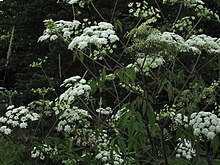water hemlock
Search
Wikipedia
| Cicuta maculata | |
|---|---|

| |
|
Scientific classification | |
| Kingdom: | Plantae |
| Clade: | Tracheophytes |
| Clade: | Angiosperms |
| Clade: | Eudicots |
| Clade: | Asterids |
| Order: | Apiales |
| Family: | Apiaceae |
| Genus: | Cicuta |
| Species: |
C. maculata
|
| Binomial name | |
|
Cicuta maculata | |
| Synonyms[1] | |
|
Cicuta bolanderi | |
Cicuta maculata is a highly poisonous species of flowering plant in the carrot family known by several common names, including spotted water hemlock, spotted parsley, spotted cowbane, and the suicide root by the Iroquois. It is native to nearly all of North America, from northern Canada to southern Mexico.
Description
Cicuta maculata is a rhizomatous perennial herb producing a hollow erect stem to a maximum height between 1 and 1.5 metres (3 ft 3 in and 4 ft 11 in). The long leaves are made up of several lance-shaped, pointed, serrated leaflets. Each shiny green leaflet is 2 to 10 centimetres (1 to 4 in) long and the entire leaf may be up to 40 centimetres (16 in) long. The inflorescence of white flowers is similar in appearance to other species in the carrot family. It is a compound umbel with many clusters of flowers. The dry tan-brown fruit is a few millimeters long.
Toxicity
The plant is occasionally mistaken for parsnips, due to its clusters of white tuberous roots; this is an often fatal error, as the Cicuta is extremely poisonous. It is considered to be North America's most toxic plant.[2][3][4]
Cicuta is fatal when swallowed, causing violent and painful convulsions. Though a number of people have died from water hemlock poisoning over the centuries, livestock have long been the worst affected (hence the name "cowbane"), causing death in as little as 15 minutes.[5][6]
The chief poison is cicutoxin, an unsaturated aliphatic alcohol that is most concentrated in the roots. Upon human consumption, nausea, vomiting, and tremors occur within 30–60 minutes, followed by severe cramps, projectile vomiting, and convulsions. Occasional long-term effects include retrograde amnesia.[7] Ingestion of water hemlock in any quantity can result in death or permanent damage to the central nervous system.
See also
References
- ^ "Cicuta maculata". Germplasm Resources Information Network (GRIN). Agricultural Research Service (ARS), United States Department of Agriculture (USDA). Retrieved 12 January 2018.
- ^ Schep LJ, Slaughter RJ, Becket G, Beasley DM (April 2009). "Poisoning due to water hemlock". Clin Toxicol. 47 (4): 270–8. doi:10.1080/15563650902904332. PMID 19514873. S2CID 21855822.
- ^ "ARS". usda.gov.
- ^ 'Do not eat, touch, or even inhale the air around the Machineel Tree' (Atlas Obscura) Accessed 14 August 2019
- ^ "Poison Plants (California Veterinary Association)". Archived from the original on 12 September 2007. Retrieved 10 July 2008.
- ^ USDA Plants Profile
- ^ Costanza, David J.; Hoversten, Vincent W. (1973). "Accidental Ingestion of Water Hemlock". Calif Med. 119 (2): 78–82. PMC 1455113. PMID 4726956.
External links
| Wikimedia Commons has media related to Cicuta maculata. |
- Jepson Manual Treatment
- Photo gallery
- "Water Hemlock: Cicuta maculata". Illinois Wildflowers. Retrieved 31 July 2021.
- Fertig, Walter. "Water Hemlock (Cicuta maculata or Cicuta maculata (DC.) J.M. Coult. & Rose)". U.S. Forest Service. Retrieved 31 July 2021.
- "Cicuta maculata L.". Go Botany. Retrieved 31 July 2021.

